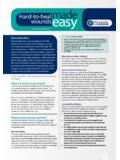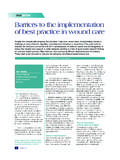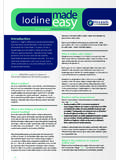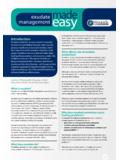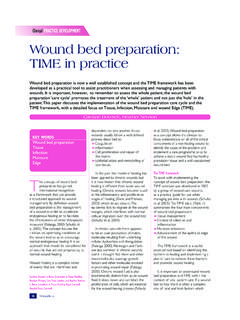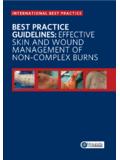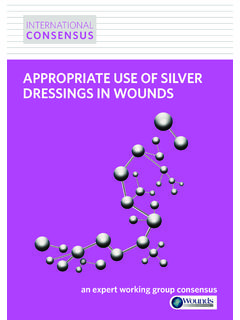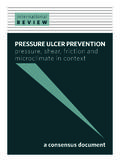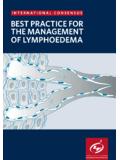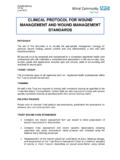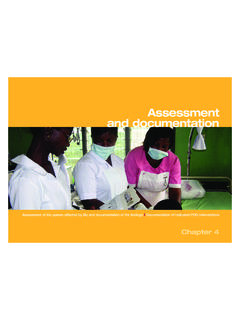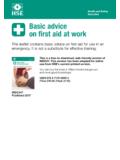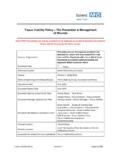Transcription of Wound infection in clinical practice An international ...
1 PRINCIPLES OF. BEST practice . A World Union of Wound Healing Societies' Initiative Wound infection in clinical practice An international consensus MANAGING EDITOR: FOREWORD. Lisa MacGregor Wound infection continues to be a challenging problem and represents a considerable HEAD OF Wound CARE: healthcare burden. Early recognition along with prompt, appropriate and effective Suzie Calne intervention are more important than ever in reducing its economic and health EDITORIAL PROJECT consequences, especially in the context of growing resistance to antibiotics. MANAGER: Kathy Day This important document represents the consensus opinion of an international panel MANAGING DIRECTOR: of experts who met in 2007.
2 A major strength of this meeting was the open sharing of Jane Jones the realities and practicalities of treating Wound infection in many different situations. PRODUCTION: Alison Pugh The content of this document has been carefully considered to relate directly to daily DESIGNER: clinical practice . In particular, it provides broad, clear and safe guidance on the areas Jane Walker of diagnosis and the topical/systemic treatment of bacterial Wound infection . The PRINTED BY: wide disciplinary and geographical representation of the panel ensures that the Printwells, Kent, UK principles presented are both practical and adaptable for use in local settings FOREIGN worldwide.
3 Research will continue to provide greater understanding of Wound TRANSLATIONS: infection and to shape future practice . RWS Group, London, UK Professor Keith Harding PUBLISHED BY: Medical Education Partnership (MEP) Ltd Omnibus House 39 41 North Road London N7 9DP, UK Key Tel: + 44 (0)20 7715 0390. ! ? Fax: +44 (0)20 7715 0391 Education more Research areas Alert key points of Email: detailed information to requiring further information/evidence Web: support clinical practice investigation MEP Ltd 2008. Acknowledgements: Figure 2 is copyright of Department for Plastic EXPERT WORKING GROUP. Surgery, Hand and Burn Keryln Carville, Silver Chain Nursing Association and Curtin University of Surgery, University Hospital Technology, Perth (Co-Chair; Australia).
4 Of RWTH, Aachen. Figure 3 is copyright of the Janet Cuddigan, University of Nebraska Medical Center, Omaha, Cardiff and Vale NHS Trust Nebraska (USA). Professor Keith Harding. Jacqui Fletcher, University of Hertfordshire, Hatfield (UK). Paul Fuchs, University Hospital of RWTH, Aachen (Germany). Supported by an unrestricted educational grant from Smith Keith Harding, Wound Healing Research Unit, Cardiff University & Nephew. The views (Chair; UK). expressed in this document Osamu Ishikawa, Gunma University Graduate School of Medicine, do not necessarily reflect Maebasi (Japan). those of Smith & Nephew. David Keast, University of Western Ontario, London, Ontario (Canada).
5 How to cite this document: David Leaper, Wound Healing Research Unit, Cardiff University (UK). World Union of Wound Healing Societies (WUWHS). Christina Lindholm, Kristianstad University (Sweden). Principles of best practice : Prashini Moodley, University of KwaZulu Natal, Durban (South Africa). Wound infection in clinical Elia Ricci, St Luca's Clinic, Pecetto Torinese (Italy). practice . An international consensus. London: MEP Greg Schultz, University of Florida, Gainesville, Florida (USA). Ltd, 2008. Available from Jose Vazquez, Wayne State University, Detroit, Michigan (USA). PRINCIPLES OF BEST practice . 1. Healy B, Freedman A. Even though it is virtually inevitable that most wounds contain micro-organisms, many heal ABC of Wound healing.
6 Successfully. However, sometimes micro-organisms (particularly bacteria) multiply, invading and infections . BMJ 2006; 332: 838-41. damaging tissues, delaying healing and occasionally causing systemic illness. The potential for bacteria to produce harmful effects is influenced by the: ability of the patient's immune system to combat the bacteria (host resistance). number of bacteria introduced higher numbers are more likely to overcome host resistance type of bacteria introduced: some bacteria have greater disease-producing ability (virulence) than others, and may be able to cause disease in relatively low numbers benign residents in one body site may cause disease if transferred elsewhere.
7 ! Wounds usually contain bacteria often without detrimental effect DEFINITIONS. The presence of bacteria in a Wound may result in: contamination the bacteria do not increase in number or cause clinical problems Note colonisation the bacteria multiply, but Wound tissues are not damaged The focus of this infection the bacteria multiply, healing is disrupted and Wound tissues are damaged (local document is bacterial infection ). Bacteria may produce problems nearby (spreading infection ) or cause systemic Wound infections . illness (systemic infection ) (Figure 1). However, clinicians should be aware that Localised infection is often characterised by the classical signs and symptoms of inflammation other micro- organisms, eg fungi or pain, heat, swelling, redness and loss of function.
8 However, particularly in chronic wounds, viruses, may cause bacteria may cause problems, eg delayed (or stalled) healing, in the absence of such obvious Wound infection , indicators of inflammation. Some clinicians refer to this more subtle state of localised infection particularly in patients as critical colonisation', or covert' or occult' infection . Whatever term is used, when the with impaired immune bacteria in a Wound cause problems, intervention is required to prevent deterioration defences and to facilitate Wound healing. Figure 1 | Interaction Increasing clinical problems between bacteria and host (adapted from1. with permission).. Localised Spreading Systemic Contamination Colonisation infection * infection infection Vigilance required Intervention required *Localised infection may or may not be accompanied by the classical signs and symptoms of inflammation.
9 When it is not, various terms have been used, eg critical colonisation (see main text). Further research is required to fully understand the factors involved in the transition from ? colonisation to localised infection . This may facilitate future guidance regarding the timing and nature of intervention APPLICATION TO practice . Intervention is usually required only when the patient is at a high risk of Wound infection (see page 2) or when the interaction between the bacteria in a Wound and the host's defences impairs healing, causes further damage, and results in localised, spreading or systemic infection Wound infection IN clinical practice | 1. DIAGNOSIS.
10 Figure 2 | Pocketing The diagnosis of Wound infection is made mainly on clinical grounds. assessment should Smooth, non- include evaluation of the patient, the tissues around the Wound and the Wound itself for the granulating areas in the signs and symptoms of Wound infection , as well as for factors likely to increase the risk and base of a Wound severity of infection . Incorporation of assessment for Wound infection into routine Wound surrounded by practice will aid early detection and subsequent treatment. granulation tissue. RISK OF infection . The risk of Wound infection is increased by: any factor that debilitates the patient, impairs immune resistance or reduces tissue perfusion, eg: comorbidities diabetes mellitus, immunocompromised status, hypoxia/poor tissue perfusion due to anaemia or arterial/cardiac/respiratory disease, renal impairment, malignancy, rheumatoid arthritis, obesity, malnutrition medication corticosteroids, cytotoxic agents, immunosuppressants psychosocial factors hospitalisation/institutionalisation, poor personal hygiene, unhealthy lifestyle choices certain Wound characteristics (Box 1) or poor standards of Wound care related hygiene.
